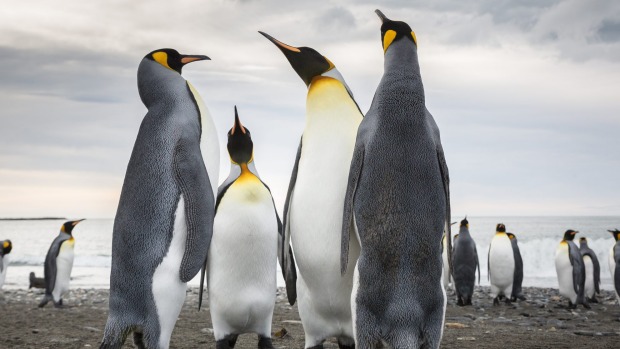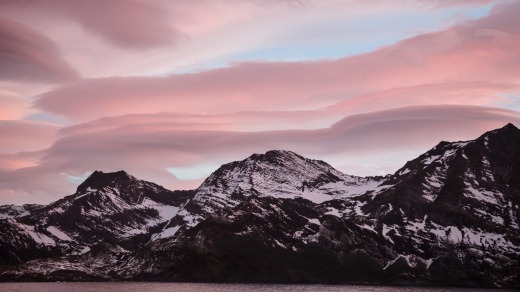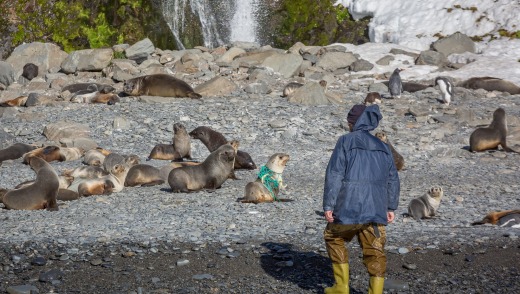
South Georgia's incredible wildlife encounters will keep you wide awake and wondering what will happen next.
I am in Antarctica, and I have barely slept. After almost three weeks on board Aurora Expeditions' ice-strengthened vessel the Polar Pioneer, I am running on pure adrenalin: thrilled, overwhelmed and exhausted. I've seen orcas and capsizing glaciers, penguins popping through the water and leopard seals catching their prey.
But on one of our final landings in South Georgia, I succumb to the need for a nap. Using a few lifejackets as a makeshift mattress and my hands as a pillow, I lie back on the pebble beach on this remote subantarctic island, and close my eyes.

As I drift off, a nudge at my foot rouses me from potential slumber. I ignore it, assuming it is a fellow passenger, playfully letting me know it's time to return to the boat. But it happens again, and I open one eye to find myself completely surrounded. Not by people, but by more than a dozen king penguins.
The bright sunlight makes their egg yolk-yellow collars glow. A few of the penguins cock their head to the side. One squawks. Most stare directly down their beak at me, looking slightly confused as to exactly what sort of creature I am.
Lying as still as I can so as not to startle them, I extend a gloved hand up towards the sky, stretching my fingertips. Using his beak, one penguin leans forward and starts pecking gently at my fingertips. I close my eyes, but there's no chance I'll sleep: once again, I am throbbing with adrenalin, wide awake and in complete awe.

While most Antarctic cruises focus on getting tourists to the Antarctic Peninsula, only a small number of departures visit South Georgia, a subantarctic island in the South Atlantic. Claimed for the British by Captain Cook in 1775, the island was plundered by sealers and whalers in the 19th and 20th century, pursuits that decimated the island's wildlife. Today, it is only accessible by boat and inhabited by just a small team of administrators and scientists.
The trip to South Georgia adds days at sea to an Antarctic expedition, but those that suffer through the wild weather in the Scotia Sea are rewarded with one of the most spectacular concentrations of wildlife in the world. Over 4 million Antarctic fur seals populate the island, along with 400,000 elephant seals.
Endangered birds like the wandering albatross nest in the cliffs around the island, and then there are the penguins: over 400,000 breeding pairs of king penguins, 2 million macaronis, 100,000 gentoos and 6000 chinstraps, all battling for nesting space on the fringes of an island just 170 kilometres long and 40 kilometres across at its widest point.
The sheer volume of animals that populate South Georgia is overwhelming to encounter – and not just because of the smell. Fur seal pups greet the Zodiacs on shore like a pack of unruly stray dogs, barking and snapping before being shooed away. Elephant seals lay indifferent in blobby lines, belching and farting rhythmically but barely raising an eyebrow to our presence.
Penguins adopt a stealthier approach. If you feel like you're being followed, you most likely are: turn around, and you'll find the sneaky little flippers behind you.
The wildlife is so abundant that it's hard to imagine that man's presence on the island once drove many of these species to the brink of extinction. However, on a Zodiac cruise to see macaroni penguins in Hercules Bay, we see the impact man still has on the islands.
Nigel, the ship's naturalist, is first to see it: an adolescent fur seal caught in fishing net, the green nylon carving deep red welts in its skin. While we watch from the boats, Nigel and our expedition leader, Howard, head to shore to try to free the animal.
Wrangling the frightened and vicious seal isn't an easy task: the animal thrashes his body and lunges at the men, constantly trying to bite. Even when pinned, it's delicate work: the men having to slice through the net and also free the rope embedded in its skin. It's a tense few minutes, but suddenly they're done; the seal is released, the rescuers wave, and the crowd go wild.
Later that night, the fishing net is auctioned off, fetching hundreds of dollars for the South Georgia Heritage Trust. But feeling the pull of sleep, I leave the auction early, slipping into my bunk.
Just as I'm drifting off, an announcement is made over the ship's PA: first in English for passengers, then in Russian for our crew. Lenticular clouds are forming in the sky above the South Georgia coast, just as the sun is setting. The deck floods with passengers, crew and camera equipment as everyone drinks in this rare meteorological event.
But not to be upstaged, the wildlife of South Georgia once again shows us who is boss. A humpback whale appears starboard side, tail fluking, flipper slapping and generally demanding our attention. Sleep, it seems, will have to wait.
auroraexpeditions.com.au or call 1800 637 688.
LAN Airlines fly to Santiago (via Auckland), connecting to Buenos Aires and then on to Ushuaia. Fares vary, but in November 2014 sale fares can be found from $1994.28 (including tax).
See lan.com.
Aurora Expeditions' Polar Pioneer cruises to Antarctica from November-March, with five departures that visit South Georgia. Their 20-day Photographers South Georgia & Antarctica voyage departs Ushuaia on 3rd November and costs from $US13,660 per person.
A fully inclusive package, which includes their 20-day Shackleton Spirit expedition, return economy airfares to South America (ex Sydney), one night in Punta Arenas before voyage, three nights in Buenos Aires and half-day city tour post voyage and all airport transfers, departs March 9 and costs from $17,595.
The writer travelled as a guest of Aurora Expeditions